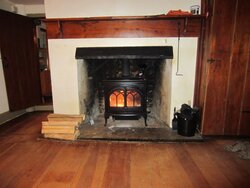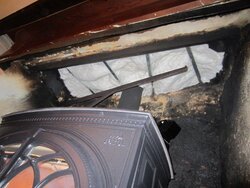Howdy,
I've searched on Google to find an answer with no luck, but I did luckily find this forum. I also searched the forum using the word "inswool" but the 4 threads that came up did not have any mention of my situation.
I'll try to make it as short as I can. What I basically have is a question about Inswool being used to close up the hole in the flue after the rear of the damper (damper question below) was smashed out (by the installer), the stove was put in and Inswool and only Inswool was used to close the hole in chimney flue.
I have a house built in 1790 with 4 fireplaces. One of those being what I have heard called a "Walk in" fireplace. The opening is basically 4 feet wide and 4 feet tall. So you can imagine the flue is huge as is or was the flue housing.
I had a wood stove put in by a so called professional. He smashed the back of the damper housing out and removed that section and the flap. Shoved the stove in my fireplace opening and now was left with a hole approximately 3 feet wide by 2 feet deep on top of the stove going up the chimney flue.
Anyone familiar with basement insulation and rafters might have seen how some unfinished basements that are insulated have rods that hold up the insulation between the rafters. Well basically what I am getting at is the installer cut some aluminum rods, rested those in my flue from front to back and then laid some Inswool on top of them as his solution to close the hole.
Now I've searched the web and cant find any mention of using this as a way of closing the flue.
What I have found is the MSDS for Inswool basically telling me how bad this stuff is to breath. Fibers cause cancer. And other good stuff like that.
So I cant say I'm too happy with his solution. Problem is he tells me "Thats how everyone does it" "Its the industry standard".
Well like I said, if everyone did it that way, why cant I find any mention of it anywhere.
So I ask you my fellow wood stove users what do you think? As I'm not happy about this solution and I've already found fibers on top of the stove from the Inswool so I know its got to be in the air.
Also I asked why he smashed out the complete housing and not just cut out an area big enough for the stove pipe to go up, then I would have at least had the rest of the damper housing and damper flap to close off a huge section of the hole.
Now I know some people are saying of course he had o smash it out to make room, but as mentioned about the flue is huge and so was the damper. An average person of average height and weight could most likely climb up it if they had rock wall climbing experience.
Is that also industry standard to smash out the damper housing?
Thanks Much
I've searched on Google to find an answer with no luck, but I did luckily find this forum. I also searched the forum using the word "inswool" but the 4 threads that came up did not have any mention of my situation.
I'll try to make it as short as I can. What I basically have is a question about Inswool being used to close up the hole in the flue after the rear of the damper (damper question below) was smashed out (by the installer), the stove was put in and Inswool and only Inswool was used to close the hole in chimney flue.
I have a house built in 1790 with 4 fireplaces. One of those being what I have heard called a "Walk in" fireplace. The opening is basically 4 feet wide and 4 feet tall. So you can imagine the flue is huge as is or was the flue housing.
I had a wood stove put in by a so called professional. He smashed the back of the damper housing out and removed that section and the flap. Shoved the stove in my fireplace opening and now was left with a hole approximately 3 feet wide by 2 feet deep on top of the stove going up the chimney flue.
Anyone familiar with basement insulation and rafters might have seen how some unfinished basements that are insulated have rods that hold up the insulation between the rafters. Well basically what I am getting at is the installer cut some aluminum rods, rested those in my flue from front to back and then laid some Inswool on top of them as his solution to close the hole.
Now I've searched the web and cant find any mention of using this as a way of closing the flue.
What I have found is the MSDS for Inswool basically telling me how bad this stuff is to breath. Fibers cause cancer. And other good stuff like that.
So I cant say I'm too happy with his solution. Problem is he tells me "Thats how everyone does it" "Its the industry standard".
Well like I said, if everyone did it that way, why cant I find any mention of it anywhere.
So I ask you my fellow wood stove users what do you think? As I'm not happy about this solution and I've already found fibers on top of the stove from the Inswool so I know its got to be in the air.
Also I asked why he smashed out the complete housing and not just cut out an area big enough for the stove pipe to go up, then I would have at least had the rest of the damper housing and damper flap to close off a huge section of the hole.
Now I know some people are saying of course he had o smash it out to make room, but as mentioned about the flue is huge and so was the damper. An average person of average height and weight could most likely climb up it if they had rock wall climbing experience.
Is that also industry standard to smash out the damper housing?
Thanks Much



